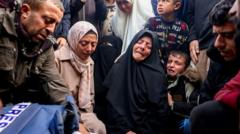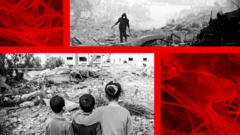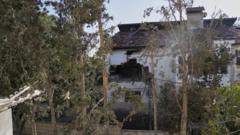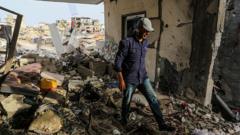As ceasefire negotiations await final approval, 73 casualties have been reported due to Israeli airstrikes in Gaza, igniting concern about ongoing violence and humanitarian crises. The situation remains tense as key political leaders and military officials navigate last-minute challenges in holding agreements.
Escalating Violence in Gaza Amidst Pending Ceasefire Agreement

Escalating Violence in Gaza Amidst Pending Ceasefire Agreement
Israeli airstrikes continue to escalate in Gaza leading up to a proposed ceasefire, claiming numerous lives and complicating negotiations with Hamas.
Israeli airstrikes resume in Gaza just before a ceasefire agreement and hostage exchange deal with Hamas is anticipated to commence on Sunday, pending affirmation from Israel’s cabinet. The latest reports from Gaza's Hamas-run civil defense indicate that 73 individuals were killed overnight, with a significant toll stemming from strikes that hit residential areas, including 12 residents in the Sheikh Radwan neighborhood of Gaza City.
Leading up to the ceasefire, Israeli Defense Forces had mistakenly reported a "fallen projectile" in southern Israel, which resulted in clarification that it was a misidentification. This pattern of intense military activity prior to ceasefire announcements is reminiscent of previous conflicts, such as the airstrikes in Lebanon before a truce last November.
Israeli Prime Minister Benjamin Netanyahu is expected to ratify the ceasefire agreement, although his office claims that Hamas has not fully complied with the terms, leading to a potential "last-minute crisis." In contrast, a senior Hamas official has assured that the group is committed to the terms as communicated to mediators in Qatar and Egypt.
On the political front, two far-right ministers in Netanyahu's coalition government have insisted they may resign if the ceasefire proceeds, a decision that could instigate further elections in Israel. Nevertheless, analysts maintain that Netanyahu could still drive the deal forward if he opts to do so.
The ceasefire plan consists of multiple phases. The initial six-week term is expected to facilitate the release of 33 hostages alongside a reciprocal exchange for Palestinian prisoners from Israeli jails. Concurrently, Israeli forces will withdraw from densely populated areas, allowing displaced residents to return and enabling aid deliveries to commence.
Negotiations for the subsequent phases will kick off after the first six weeks, targeting the release of remaining hostages, a complete troop withdrawal from Gaza, and strategies to establish lasting peace. The final phase revolves around recovering the remains of any deceased hostages and navigating the extensive reconstruction of Gaza, a feat described by Achim Steiner from the UN Development Programme as requiring the removal of an estimated 40 million tons of debris.
The humanitarian crisis in Gaza is dire, with estimates indicating over 46,700 fatalities and widespread displacement among the 2.3 million residents since the onset of hostilities triggered by an unprecedented attack by Hamas on October 7, 2023. Reports highlight a scarcity of food, fuel, and medical supplies, as aid organizations grapple with barriers to assistance delivery.
Amidst this tumult, the fate of 94 hostages still held by Hamas remains uncertain, with fears for the presumed status of 34 individuals believed to be deceased. A staggering number of buildings in Gaza—approximately 58.9%—are estimated to have sustained damage, complicating the path towards recovery and reconciliation for the region.




















